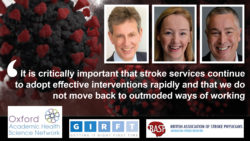 Practical guidance to help stroke teams across England deliver high-quality care in the restoration and recovery phase of the Covid-19 pandemic has been made available in a collaboration between the Oxford AHSN and the stroke leads for the Getting It Right First Time (GIRFT) programme.
Practical guidance to help stroke teams across England deliver high-quality care in the restoration and recovery phase of the Covid-19 pandemic has been made available in a collaboration between the Oxford AHSN and the stroke leads for the Getting It Right First Time (GIRFT) programme.
Restoration and recovery of stroke services during the Covid-19 pandemic assesses the impact of rapid changes made across the whole stroke pathway – including community services – at the peak of the pandemic, outlining new ways of working which have been beneficial for both patients and staff and should be continued and extended. It also aims to highlight those changes which now need a closer look and prevent a return to less effective ways of working.
The guidance is written by Oxford AHSN chief executive Professor Gary Ford with GIRFT’s joint stroke leads, Dr Deb Lowe and Dr David Hargroves, and can be found on the British Association of Stroke Physicians (BASP) resource hub.
Professor Ford, who is also a practising stroke physician, said: “This has been a joint effort between the GIRFT stroke leaders and the Oxford AHSN team, bringing together great examples of innovation and improvement across the stroke pathway from all over the country. We hope stroke teams will continue to share best practice as we move further into the restoration and recovery phase of the pandemic.”
Based on ongoing discussions with stroke teams at the height of the pandemic and since, the report addresses common themes such as:
- Staff wellbeing: Returning to rotas and sustainable ways of working, while recognising the emotional and psychological impact of delivering care during a pandemic.
- Efficiency measures: Acknowledging that a reduction in efficiency is inevitable due to the need for enhanced cleaning and the use of personal protective equipment (PPE). It is also noted that while virtual clinics are highly effective, they can take longer than face-to-face methods.
- Testing: Advocating rapid Covid-19 tests in the emergency department (ED) for all suspected stroke patients, as well as regular tests for staff.
- Transient Ischaemic Attack (TIA) services: Reviewing pathways to ensure the continuation of virtual methods for TIA services.
- Infection control: Adapting handover practices, safety huddles and multidisciplinary team meetings to maintain social distancing to reduce the spread of Covid-19.
- Transfer of care between settings: Addressing the balance between the need for rapid supported discharge to reduce the risk of hospital-acquired infection and protecting community settings.
- Early supported discharge (ESD) and community rehabilitation: Maintaining the provision of seven-day ESD services established during the pandemic, and resuming community-based rehabilitation. Virtual rehabilitation could be used where appropriate, but offered alongside face-to-face contact (with PPE and infection control precautions) to maximise the rehabilitation potential of stroke survivors.
The latest guide is a follow-up to Adapting stroke services in the Covid-19 pandemic, issued by the same authors in May 2020.
It contains case studies of good practice to encourage stroke teams to adopt beneficial changes. For example, the Northampton Community Stroke Team is highlighted for its use of virtual technology in providing rehabilitation after hospital discharge. At the height of the pandemic, the team was able to send patients activity plans and establish a rapport through video calling, allowing rehabilitation and movement analysis to be completed remotely.
Dr David Hargroves, GIRFT joint lead for stroke and a consultant physician for stroke medicine at East Kent Hospitals University NHS Foundation Trust, said: “The pandemic has demonstrated the ability of NHS stroke services to adapt and change rapidly and use digital and artificial intelligence technologies. It is critically important that stroke services continue to adopt effective interventions rapidly and that we do not move back to outmoded ways of working.”
Joint GIRFT lead Dr Deb Lowe, who is also the National Clinical Director for stroke medicine for NHS England and NHS Improvement, added: “We hope this document provides pragmatic guidance to support acute and community teams to continue to deliver high-quality stroke care while maintaining staff wellbeing and safety.”
The guidance was written with input from Dr Guy Rooney, Medical Director at the Oxford AHSN; Stroke Association Senior Lecturer Dr Rebecca Fisher; Hannah Oatley, Clinical Innovation Adoption manager at the Oxford AHSN; and medical writer Jemma Lough. It is supported by the British Association of Stroke Physicians.
BASP president Professor Rustam Al-Shahi Salman, said: “Stroke physicians are more isolated than ever as a result of the COVID-19 pandemic. Beforehand, 40-50% of Trusts had an unfilled stroke physician post. Now, we need to learn and deliver new ways of working alone, with few colleagues around us, or educational meetings to inspire and support us. That’s the gap that this new guidance fills.”
This is intended to be an evolving guide. The authors welcome submission of more examples of real-life solutions put into practice to address these and other stroke service challenges now and during the restoration and recovery period. They can use the case study form to submit examples. These will be added to the guide’s resource hub for sharing best practice.

